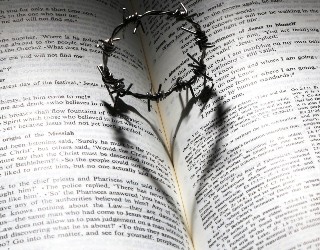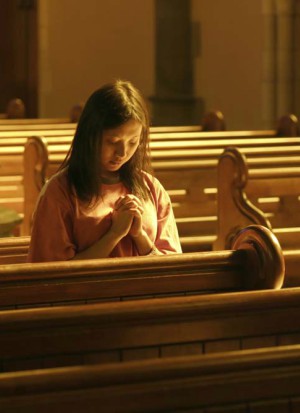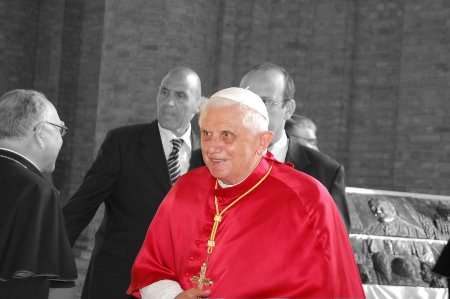We ask you, humbly: don't scroll away.
Hi readers, it seems you use Catholic Online a lot; that's great! It's a little awkward to ask, but we need your help. If you have already donated, we sincerely thank you. We're not salespeople, but we depend on donations averaging $14.76 and fewer than 1% of readers give. If you donate just $5.00, the price of your coffee, Catholic Online School could keep thriving. Thank you.Help Now >
Pope Benedict, Good Liturgy, Sacred Art and the Divine Mercy Image
Pope Benedict XVI, at the turn of the millennium, in one of his best known books, "The Spirit of the Liturgy" wrote extensively on the need for sacred art in every Catholic Church. He wrote of the misunderstanding of Vatican II and how the removal and destruction of images, in his own words, "left behind a void, the wretchedness of which we are now experiencing in a truly acute way". Not only is the Divine Mercy image most appropriate for Divine Mercy Sunday, as our Lord Jesus stated, but it is also most appropriate for everyday liturgy.
Highlights
Catholic Online (https://www.catholic.org)
4/10/2010 (1 decade ago)
Published in Lent / Easter
P>PORT ST. LUCIE, FL (Catholic Online) - Not many of us are aware that our current Pope, Benedict XVI had recommended the re-introduction of icons and images into our Churches. To most Catholics this comes as a very welcomed surprise.
Pope Benedict XVI, at the turn of the millennium, in one of his best known books, "The Spirit of the Liturgy" wrote extensively on the need for sacred art in every Catholic Church. He wrote of the misunderstanding of Vatican II and how the removal and destruction of images, in his own words, "left behind a void, the wretchedness of which we are now experiencing in a truly acute way".
He spoke of the "crisis of art" today being "a symptom of the crisis of man´s very existence". We don´t have to go too far to see the "sense-less" art that is prevalent today. Modern sacred art with its unrealistic and odd-shaped corpuses and statues does nothing to bring to mind anything of the sacred at all if it is not truly life-like. Our churches need to be adorned with sacred art that lifts our souls to a view of our heavenly home, where the saints abide with the Father, Son, and Holy Spirit.
Pope Benedict states "lack of images is incompatible"
The Pope explains, "The complete absence of images is incompatible with faith in the Incarnation of God. God has acted in history and entered into our ´sensible´ world, so that it may become transparent to him. Images of beauty, in which the mystery of the invisible God becomes visible, are an ´essential´ part of Christian worship". Note here that the Pope said "images of beauty" and not modern art.
What is most remarkable in the twenty plus pages that the he dedicated to sacred art in this book is the prevalence of the description of an image that could only be the Divine Mercy image itself. He not only noted that it was wrong to remove the images and icons, but he went on to explain what the perfect image would have to embrace and only the Divine Mercy image could possibly meet all of his criteria.
I would challenge you to pick-up a copy of this book and fasten your seat belt. As you read Part Three, Art and Liturgy, The Question of Images, keep in mind all the details of the Divine Mercy image. His thorough explanation of the essentials of sacred art, that is ordered to divine worship, could only apply to an image that has all the aspects of the Divine Mercy image that Jesus requested to be painted.
His brilliant and methodical explanation of sacred art is truly a masterpiece that everyone should read. Re-reading only takes you deeper into the intellect, which this Pope has, probably second to none, concerning liturgical worship throughout the ages. The more you read, the more you come to understand the importance and significance of having the Divine Mercy image in every single Catholic parish.
Not only is the Divine Mercy image most appropriate for Divine Mercy Sunday, as our Lord Jesus stated, but it is also most appropriate for everyday liturgy. On Mercy Sunday, all of the readings, starting from the Opening Prayer, direct us to focus on the redeeming Blood, the washing away of sins in Water, a new birth in the Spirit, the institution of confession, and the importance of trusting in Jesus.
The Pope said "On liturgical feasts the deeds of God in the past are made present. The feasts are a participation in God´s action in time, and the images themselves, as remembrance in visible form, are involved in the liturgical re-presentation." He spoke of the images as being a "path of hope, into which the images draw us, giving us the assurance of the world to come, of the final coming of Christ".
The Divine Mercy image is truly a "path of hope" which will lead us safely to the "final coming of Christ". Jesus gave us this image specifically to give us hope and to give us a constant re-assurance that will lead us safely home to His coming. The words "Jesus, I trust in You" have been a great comfort to many people, especially in the parishes that have permanently installed images in their liturgical settings.
Benedict wrote "The icon is intended to draw us onto an inner path, the eastward path, toward the Christ who is to return. Its dynamism is identical with the dynamism of the liturgy as a whole... In the liturgy the curtain between heaven and earth is torn open, and we are taken up into a liturgy that spans the whole cosmos." The Divine Mercy image portrays Christ coming to us from heaven and opening up that curtain and bestowing upon us His inexhaustible grace and mercy.
It is interesting to note that Pope Benedict said the images "have a reference to the sacraments, and above all, to Baptism and the Eucharist, and, in pointing to the sacraments, they are contained within them... they are essentially connected with what happens in the liturgy. Jesus told us that the two rays in the Divine Mercy image denote the Blood (the Eucharist) which is the life of souls, and the Water (Baptism) that makes souls righteous. Jesus also indicated that we would receive graces from these images, and why not, if the sacraments are contained with them.
The Pope continued to explain "the center of the icon of Christ is the Paschal Mystery: Christ is presented as the Crucified, the risen Lord, the One who will come again and who here and now hiddenly reigns over all. Every image of Christ must contain these three essential aspects of the mystery of Christ and, in this sense, must be an image of Easter".
The Divine Mercy image is the image of the risen Christ on that first Easter on the evening of the Resurrection, miraculously appearing there in the Upper Room and bestowing on the Apostles the power of the Holy Spirit to forgive sins. His hand is
raised in blessing, he shows them His wounds, and Jesus is looking for their trust. Recall that St. Thomas, the doubter, was not there on that first Easter Sunday, but was actually there on the "Second Sunday of Easter", the very first Divine Mercy Sunday. Now we can see why Jesus insisted that the Divine Mercy image, with the words "Jesus, I trust in You" be in view and venerated in our churches on that day.
The Divine Mercy image portrays, not only the sacraments of Baptism and the Eucharist, that Benedict XVI indicated as being essential, but as Pope John Paul II indicated in one of his Divine Mercy Sunday homilies, also portrays, in the clear light ray representing the water, the giving of the Holy Spirit which is present in all the other sacraments of the Church.
It is very clear that our Holy Father wrote this book with the intention of pouring out his heart to all of us, so that we might bring life and hope back into the liturgy. His many years as one of the Church´s foremost theologians and as the Prefect of the Congregation for the Doctrine of the Faith, has earned him everyone´s respect. It would be of great benefit for everyone to read this book, including all the clergy.
His message of hope, which has become his hallmark, was very prevalent in this work, which was written just five years before his election to the Papal office. He often mentioned the word "hope" and associated it with the Second Coming of Christ. Indeed, this is our hope, and this image of the Divine Mercy was designed by our God, to bring us precisely this hope, and trust, as we grow ever closer to that long-awaited Second Coming of Christ.
The Divine Mercy image perfectly fits every single fundamental principal and indentifying element that our Pope has so painstakingly described. Only by reading this masterful work will we come to understand the depth of the Pope´s insight and into the urgent need to re-invigorate our churches with sacred art that is ordered to the liturgy, of which no other image could represent so precisely as the Divine Mercy image itself.
Is it any wonder, why his predecessor, Pope John Paul II worked so hard to make us all understand how important Divine Mercy is? There is no doubt that the Holy Spirit was working through our Church and the Vicar of Christ to bring about this path of hope. The World Congress on Mercy is yet another sign from heaven that now is the time for mercy. Let us take advantage now while there is time for hope.
-----
Robert R. Allard, Director of the Apostles of Divine Mercy, has been helping the Church to celebrate Divine Mercy Sunday since 1996. He had been a Fallen-away Catholic for over 25 years and received a special grace on Mercy Sunday. He has written for national magazines, newspapers, and has organized conferences and seminars. He has recently appeared on EWTN TV and Radio. His website provides information and resources, such as bulletin inserts, homilies, documents, and images.
We ask you, humbly: don't scroll away.
Hi readers, it seems you use Catholic Online a lot; that's great! It's a little awkward to ask, but we need your help. If you have already donated, we sincerely thank you. We're not salespeople, but we depend on donations averaging $14.76 and fewer than 1% of readers give. If you donate just $5.00, the price of your coffee, Catholic Online School could keep thriving. Thank you.Help Now >
---
'Help Give every Student and Teacher FREE resources for a world-class Moral Catholic Education'
Copyright 2021 - Distributed by Catholic Online








 Daily Readings for Thursday, April 18, 2024
Daily Readings for Thursday, April 18, 2024 St. Apollonius the Apologist: Saint of the Day for Thursday, April 18, 2024
St. Apollonius the Apologist: Saint of the Day for Thursday, April 18, 2024 Aspiration: Prayer of the Day for Thursday, April 18, 2024
Aspiration: Prayer of the Day for Thursday, April 18, 2024


